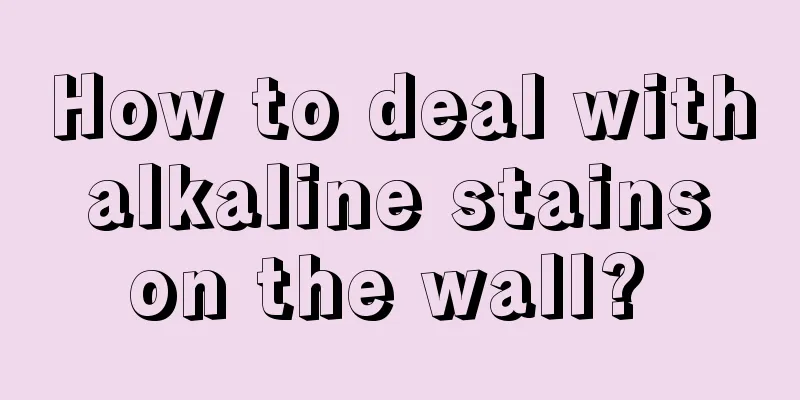How to deal with alkaline stains on the wall?

|
During renovation, the walls are often whitewashed, but if you encounter workers who are "incompetent", the walls are often not treated very cleanly. The most serious consequence is not only cracking and peeling, but also the wall surface is prone to alkaline phenomenon. When we encounter such a situation, as the owners of the house, we have to find a solution while feeling distressed. So, how to deal with wall alkali? (I) Preparation before construction 1. Consider eliminating alkali in the design and design it as dry hanging as possible; consider the waterproof treatment of the structure; select stone slabs with water absorption and other physical properties that meet the requirements. 2. Before construction, all construction process links where alkali flooding may occur should be fully considered, and preventive measures should be taken in advance. If you are not sure, you should make a sample first. 3. The relevant materials should be inspected before use. Not only the appearance and size must be qualified, but also their physical performance indicators must be qualified. (ii) Use alkali-proof backing coating 1. Before installing the stone slab, apply a special treatment agent on the back and sides of the stone. The solvent will penetrate into the stone and block the capillaries, preventing water, Ca(OH)2, salt and other substances from invading, thus cutting off the path of alkaline flooding. Without back coating treatment, alkaline blooming is inevitable, but the adhesion of the stone treated with back coating will not be affected. 2. Apply resin glue on the bottom of the stone slab, and then stick the chemical fiber mesh cloth to form a tensile waterproof layer, but don't forget to apply paint on the side. (III) Reduce the generation of Ca(OH)2, salt and other substances 1. Water reducing agent should be added to the cement mortar used for tiling to reduce the precipitation of Ca(OH)2. The consistency of mortar for pasting method should be 6-8cm, and the consistency of mortar for grouting method should be 8-12cm. 2. For outdoor tiling, cement-based commercial adhesive (dry mix) can be used. It has good water retention and can greatly reduce cement condensation and water exudation. For indoor tiling, stone chemical adhesive can be used for spot bonding. (IV) Prevent water intrusion 1. Do not spray a large amount of water on the stone and wall before operation. 2. A moisture-proof layer should be set under the ground wall. If the outer walls of water-using rooms such as toilets and bathrooms are decorated with stone, their inner walls should be treated for anti-seepage. 3. For exterior stone decorative surfaces, in order to prevent intrusion from the joints, the wall panels must be inlaid away from the joints, the joint width should not be less than 5mm, and it should be sealed with stone-specific silicone weather-resistant sealant. 4. Set up rainproof awnings for outdoor construction, and properly handle the joints between the door and window frames and the exterior walls to prevent rainwater from leaking into the walls. 5. After the tiling is completed, the entire area of the outdoor stone should be sprayed with silicone waterproofing agent or other colorless surface protective coating. Governance Once alkaline blooming occurs on natural stone walls, it is difficult to remove because the soluble alkali (or salt) substances have penetrated into the stone along the pores (those that seep out of the surface of the slab can be removed). Therefore, prevention should be emphasized. After alkaline blooming occurs, only the following remedies can be taken. 1. Carry out waterproof treatment on the walls, board seams, board surfaces, etc. as soon as possible to prevent moisture from continuing to invade and prevent the expansion of alkalinity. 2. You can use the stone alkali cleaning agent on the market. This cleaning agent is a colorless, translucent liquid made of non-ionic surfactants and solvents. It has a certain effect on cleaning alkali stains on the surface of some natural stones. However, before use, you must first make a small sample test block to test the effect and decide whether to adopt it. In short, the key to eliminating alkaline blooming on wet-pasted natural stone walls is prevention. As long as the root cause of its occurrence is discovered and strict control and scientific prevention are implemented in each link of design, materials and construction, the occurrence of alkaline blooming can be completely avoided, allowing natural stone, an ancient building material, to shine again in modern buildings. |
<<: How to deal with alkaline stains on the wall?
>>: What are the health products for hangover and liver protection?
Recommend
The benefits of drinking light salt water early in the morning
Drinking a glass of light salt water when you wak...
What to do if the knee is painful due to effusion, how to treat it
Many professional athletes may experience fluid a...
What are the advantages of ecological double eyelids?
Going to a plastic surgery institution to have do...
How to reuse diapers when they become too small
Many parents choose to use diapers for their youn...
What disease does lung shadow mean
Lung shadows must not be ignored, as they may be ...
The difference between dry white and dry red
Both dry red and dry white wine are relatively fa...
What causes colon cancer
In recent years, colorectal cancer has become one...
Can drug-induced kidney damage be recovered?
Many patients suffer from other diseases and do n...
Main treatments for skin cancer
Skin cancer is one of many tumor diseases. If you...
Ranking of the "contributors" to moisturizing the intestines and nourishing the skin: bitter foods are the best for preventing cancer and detoxification
tea The detoxifying effect of tea was recorded as...
Can people with chickenpox eat tomatoes?
Varicella is a skin disease in infants. In the pa...
What are the three major early symptoms of cervical cancer
This year, the incidence of cervical cancer in my...
How to start learning Qigong by yourself?
Qigong is the first stage of human cultivation, a...
What medicine should I take for sternum pain
After overwork, the bones in the body will feel e...
7 types of "colds" are actually serious diseases
Coughing, runny nose, sneezing, fever...are all c...









